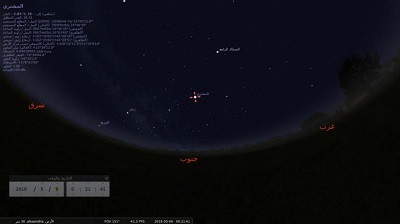By mid-May 2018, people will be observing the sky for the crescent of the holy month of Ramadan and the beginning of fasting rituals. In addition to this event and its astronomical details, the sky of May will witness other astronomical bodies and phenomena worth observing; let us outline some of their features:
Saturday, 6 May 2018
On Saturday night, 6 May 2018, we recommend that you choose a dark and high altitude spot, away from any light pollution; to join millions of amateur astronomers in observing the
Eta Aquarid meteor shower. It takes place when the Earth crosses the famous Halley’s Comet passage, causing the comet’s debris leftovers of to fall on the Earth’s surface.
If you set yourself up to watch the sky that night, you would not need any means of observation; the meteors would be visible to the naked eye. If you are located in the Southern Hemisphere, the Eta Aquarids would produce up to 60 meteors per hour. As for the Northern Hemisphere sky observers, including those observing the sky of the Arab Republic of Egypt, the rate can reach about 30 meteors per hour; a few good ones to observe.
Wednesday, 9 May 2018
On Wednesday, 9 May 2018, amateur astronomers and sky-observers will have an opportunity to observe another beautiful phenomenon known as “Jupiter at Opposition”. This phenomenon takes place when Jupiter lies directly opposite to the Sun, which means that it is in its utmost illumination condition. The planet will be visible also from Earth, and it is the best time to view and photograph the giant planet sparkling in our skies.
Jupiter can be seen with the naked eye to the south, and it will be remarkable. Using a binocular or a small-sized telescope, you can enjoy a special night with your friends while watching Jupiter's moons and unique atmosphere. The most appropriate time for observation will be at 12:00 am, according to the Stellarium Program picture. You can also roam among Jupiter, Saturn and Mars as shown in the picture.

Tuesday, 15 May 2018
On the night of Tuesday, 15 May 2018/25 Shaaban1439, Ramadan crescent will be observed right after sunset. It is impossible to observe the crescent on that day, according to astrological calculations, because moonset will occur before sunset. Accordingly, Wednesday, 16 May will mark the end of a 30-day Shaaban, and Thursday, 17 May will mark the first day of the blessed month, Ramadan.
The picture below is a screenshot from one of the most famous astronomy websites accredited for astronomical calculations that show this year’s observations conditions. Happy Ramadan!
.jpg)
 The article is published on the Planetarium Science Center website.
The article is published on the Planetarium Science Center website.